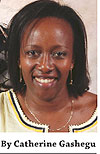Decision making has a lot to do with the art of listening, either to your heart or to what the others have to say. My old man boils it down to the sieve, a case where you have to balance what you hear with what you feel is right, and from there make a right and justified decision.


Decision making has a lot to do with the art of listening, either to your heart or to what the others have to say.
My old man boils it down to the sieve, a case where you have to balance what you hear with what you feel is right, and from there make a right and justified decision.
When it comes to policies and strategies, decisions again play an important role that will impact the day to day aspects of our lives, whether positively or negatively and the reason why ‘stakeholder consultation’ has become more and more important each day.
But any leader or decision maker knows how difficult consensus building is. The other day while preparing a presentation for an important event, a disagreement ensued over what issues should and should not be included under a certain topic.
On the one hand were the idealists who wished everything beautifully laid out on paper, and on the other the realists who knew what truly was on ground and wanted to use another approach.
Research has shown that when it comes to policy issues, there is usually a conflict of interest between policy makers (idealists) and scientists (realists), with the former looking for quick clear answers that respond to an immediate situation, and the latter usually more cautious, seeking long term solutions and answers into all the ifs and whys, and supported by analytical data and statistics.
Added to this are the personal traits and interests of each stakeholder that influence the position he/she is taking.
These traits are in the sense of individual character where some are for example very aggressive, poor losers, forward looking or laid back, which coupled with their specific interests (politicians, businessmen, pressure groups), makes it really difficult for consensus building and sound decision making.
Given the above situation, it’s up to the policy makers to make a balanced decision, whether or not agreeable, because they are challenged for optimum solutions that incorporate the interests of the stakeholders.
In any case, scientists do not always agree within themselves on the same solutions, in the event of which, the temptation for the policy maker would be to go along with stakeholder perspective closest to his/her desired outcome.
At the end of the day, it is the policy maker who has the upper hand on what is being agreed upon because he is under pressure to come up with results, and in the shortest time possible.
Given the dynamism of the World we live in, it is therefore important to limit policy makers to some dos and don’ts to ensure that decisions are closely linked to consensus. The Water Encyclopedia on Policy Making provides the following guidelines that the present day Rwanda seems to be ably handling in its own right.
First is that politicians and public servants need to understand that they are accountable to the public. Secondly, the Elites in politics and the private sector should not have the right to pursue their interests without constraints.
Thirdly, the Government bureaucratic and decision processes must be open, accessible, and transparent, as well as being responsive to public concerns.
Finally, individuals and affected communities have the right to information regarding proposed developments; the right to challenge them, and the right to be involved in the planning and decision-making processes.
As good as this sounds, today’s policy-maker has a tough job in a world that is in reality, according to Henry Venema dn John Drexhage in the need for adaptive policies’ becoming more complex than ever and highly interconnected, owing to advances in communication and transportation; and highly dynamic, owing to the scale of impact of our collective actions.
"Crafting public policies to help guide the daily actions of individuals, communities and businesses to ensure our economic, social and environmental well-being, is challenging. We know, for example, that the climate is changing, but not precisely how.
Advancing human well-being through policy, therefore, is inherently complex and dynamic. Whether policies seek to address economic conditions like household income levels; social issues such as infant mortality rates; or environmental matters such as availability of clean water, today’s policy- and decision-makers face significant uncertainty and unless they perform effectively under dynamic and uncertain conditions, they run the risk of not achieving their intended purpose, and becoming a hindrance to the ability of individuals, communities and businesses to cope with—and adapt to—change”.
At the end of the day, decision making is far and large still a case of the sieve, just balancing what you hear with what you know/feel is right to do.


